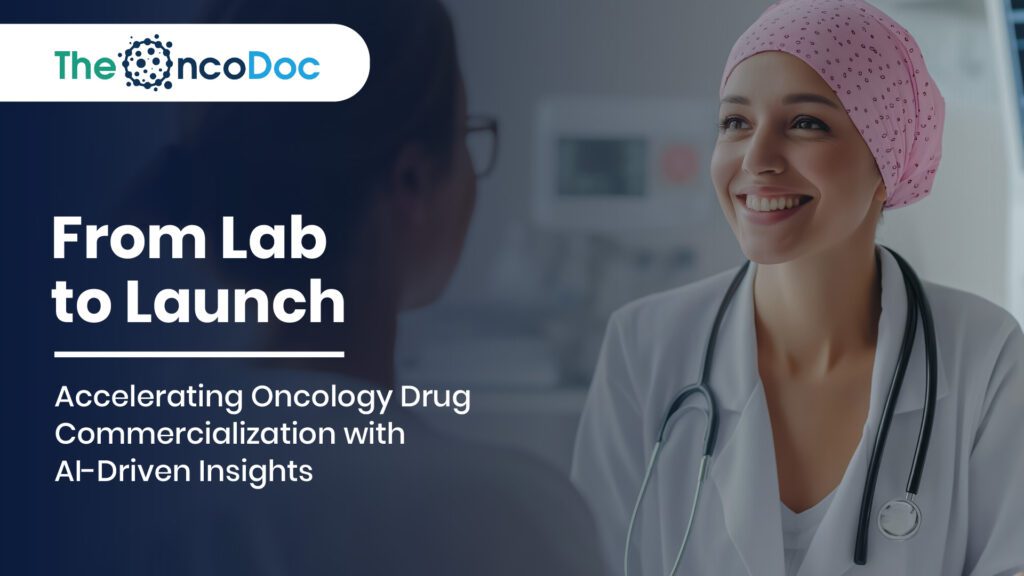Introduction: The AI-Powered Future of Oncology Commercialization
The journey of an oncology drug from discovery to market launch has traditionally been one of the longest and riskiest undertakings in the pharmaceutical industry. Bringing a single oncology therapy to patients can take over a decade, cost billions of dollars, and face high attrition rates at every step. However, artificial intelligence (AI) is rapidly transforming this process, bridging the gap between laboratory breakthroughs and commercial success.
AI enables pharma companies to streamline clinical trial design, accelerate regulatory approvals, forecast market access strategies, and design hyper-personalized commercialization campaigns. The result is a faster, more efficient, and patient-centered journey where innovative therapies can reach the right people at the right time.
This article explores AI’s role in reimagining oncology drug commercialization, breaking down its transformative impact across clinical development, regulatory approvals, market access, and go-to-market strategies.
1. Redefining the Oncology Drug Development Pipeline
Drug development in oncology is a highly complex and resource-intensive process, with most drugs failing before reaching market approval. AI is rewriting this narrative by:
- Analyzing multi-omic data: AI identifies novel targets for precision therapies by analyzing genetic, transcriptomic, and proteomic datasets.
- Predicting drug behavior: Algorithms simulate drug responses and potential adverse effects, reducing the risk of clinical trial failures.
- Prioritizing candidates: AI rapidly identifies which molecules have the highest likelihood of success, streamlining research investment.
This level of computational power enables pharmaceutical teams to design smarter development pipelines and allocate resources effectively.
2. AI-Powered Clinical Trial Design
More than half of the expenses and time spent on drug development are attributed to clinical trials, which are a major bottleneck. AI addresses these inefficiencies by:
- Predictive patient stratification: AI analyzes real-world data to match patients with therapies most likely to succeed.
- Dynamic trial design: Algorithms simulate trial outcomes under various designs, optimizing sample sizes and inclusion criteria.
- Virtual control arms: AI generates artificial control arms based on past data, which speeds up timelines and eliminates the need for sizable placebo groups.
These developments increase trial accuracy, lower trial expenses, and speed up recruitment.
3. Optimizing Patient Recruitment with AI
Recruiting patients for oncology clinical trials is often slow, expensive, and limited by geography. AI is revolutionizing this process through advanced data intelligence:
- NLP-powered analysis of electronic health records (EHRs), lab data, and physician notes uncovers eligible patients with unmatched speed and accuracy.
- AI algorithms streamline the identification of patients with rare cancers or complex conditions, dramatically reducing screening timelines.
- By identifying underrepresented locations and recruitment hotspots, geospatial analytics facilitate greater diversity and trial access.
This data-driven approach minimizes bottlenecks, accelerates trial enrollment, and ensures a more representative patient population, helping new therapies reach the market faster and patients benefit sooner.
4. Intelligent Site Selection for Clinical Trials
The likelihood of a successful trial is increased by AI-powered location selection:
- Performance analytics: AI evaluates past site success rates, investigator expertise, and patient populations.
- Operational forecasting: Algorithms predict which sites will meet enrollment goals fastest.
- Logistical optimization: AI models reduce trial delays by anticipating regulatory, supply chain, and staffing bottlenecks.
5. Automated Regulatory Submissions
The regulatory approval process is often slowed by manual, repetitive documentation. AI helps by:
- Automating dossier preparation: AI generates reports, tables, and data summaries for submissions.
- Predictive regulatory review: Algorithms anticipate regulator questions, reducing back-and-forth communication.
- Intelligent compliance tracking: AI ensures global documentation adheres to diverse regulatory standards, saving months of effort.
6. Accelerating Time-to-Market with AI
By eliminating inefficiencies, AI has the potential to reduce drug development cycles by 2–3 years. Faster commercialization benefits patients, payers, and pharma companies by enabling earlier access to breakthrough treatments while maintaining compliance.
7. AI-Driven Real-World Evidence (RWE) for Market Access
Once a drug is approved, proving its value to payers is critical. AI simplifies this by:
- Analyzing real-world patient data to demonstrate drug performance beyond clinical trials.
- Tracking outcomes across diverse demographics and comorbidities.
- Building evidence portfolios that highlight cost savings from fewer hospitalizations or improved quality of life.
RWE insights improve negotiation outcomes with insurers and policymakers.
8. Predictive Market Access Forecasting
AI enables accurate forecasting of market performance:
- Prescriber adoption modeling: AI predicts which oncologists are likely to adopt new therapies based on their networks, patient profiles, and historical data.
- Payer behavior prediction: AI identifies reimbursement trends, helping pharma teams anticipate hurdles.
- Competitive landscape analysis: Algorithms monitor competitor drug launches and pricing strategies to shape positioning.
9. AI-Powered Commercialization Strategy
Commercial success depends on targeted engagement strategies. AI enables:
- Micro-segmentation of healthcare providers (HCPs): Identifying physicians with niche expertise.
- Patient journey analytics: Mapping patient touchpoints to design personalized campaigns.
- Demand simulation: Testing messaging and pricing models for optimal uptake.
10. Hyper-Personalized HCP Engagement
Generative AI is redefining how pharma engages healthcare professionals (HCPs):
- Tailored briefing packs designed for each physician’s clinical focus and prescribing patterns.
- AI-curated educational materials aligned with preferred oncology subspecialties and treatment approaches.
- Intelligent scheduling tools predicting optimal meeting times to maximize interest and availability.
This precision-driven strategy ensures every interaction is meaningful, data-informed, and adds measurable value to the HCP experience.
11. Patient-Level Personalization
Oncology patients have unique treatment paths. AI ensures:
- Tailored educational materials based on diagnosis stage, genetic profile, and treatment options.
- Automated alerts to caregivers and patients about upcoming clinical milestones.
- Personalized adherence reminders delivered via chatbots or apps.
12. Generative AI for Content Creation
The drug launch process requires a vast amount of content, from scientific slide decks to patient-friendly brochures. Generative AI accelerates this by:
- Automating multilingual translation for global launches.
- Creating regulatory-compliant content for faster approval.
- Adapting materials for multiple channels, including mobile apps, social platforms, and webinars.
13. Forecasting Launch Risks
AI-driven simulations are redefining how pharma brands anticipate and mitigate launch risks:
- Accurately forecasting competitor activity and market entry timelines.
- Evaluating multiple pricing strategies and their market impact.
- Identifying potential supply chain vulnerabilities before they escalate.
This proactive, data-driven approach empowers companies to adjust strategies in real time, reducing uncertainty and ensuring smoother product rollouts.
14. AI-Enhanced Sales Force Optimization
AI is redefining how pharma sales teams operate, driving sharper focus and efficiency:
- Smart targeting algorithms prioritize physicians and regions based on prescribing trends and patient clusters.
- Live territory insights enable agile resource allocation and strategic call planning.
- AI-driven coaching delivers personalized feedback, boosting representative performance and engagement impact.
15. Digital Twins for Drug Commercialization
AI-powered digital twins are transforming commercialization by enabling data-driven precision:
- Virtual patient replicas model treatment outcomes across diverse demographics.
- Commercial digital twins simulate pricing scenarios, market strategies, and adoption trends.
- These advanced simulations minimize risks, accelerate decision-making, and refine launch planning with unmatched accuracy.
16. Post-Market Surveillance with AI
AI’s role doesn’t stop at launch. Post-market monitoring provides ongoing safety and efficacy validation:
- Signal detection: AI detects adverse events in real-time.
- Patient-reported outcomes: Algorithms track sentiment and side-effect data from wearables and social media.
- Adaptive strategies: Post-market findings are quickly integrated into new marketing and pricing models.
17. AI in Value-Based Care Models
With payers shifting toward value-based pricing, where reimbursement depends on measurable outcomes, AI plays a pivotal role in strengthening oncology care economics:
- Advanced analytics continuously track treatment effectiveness, patient response, and quality-of-life improvements.
- AI models demonstrate cost savings by projecting reduced hospital admissions, fewer adverse events, and optimized resource utilization.
- Robust, AI-powered data visualizations simplify complex evidence, strengthening payer negotiations and supporting favorable coverage decisions.
- This integration of AI ensures transparent, outcome-driven pricing models that align the interests of pharma, payers, and providers while ultimately improving patient access to innovative therapies.
18. AI-First Launch Campaigns
AI is revolutionizing oncology drug launches by replacing generic campaigns with deeply personalized strategies:
- Advanced predictive models pinpointing regions and networks most receptive to early adoption.
- Adaptive omnichannel campaigns that evolve in real time, optimizing engagement and ROI.
19. Real-Time Competitive Intelligence in Oncology
AI is transforming competitive intelligence by delivering actionable, real-time insights:
- Continuous Monitoring: Advanced algorithms track medical publications, regulatory filings, and conference updates to detect competitor activity instantly.
- Trend Analysis: Predictive models identify emerging market trends and competitor strategies, helping brands anticipate shifts early.
- Strategic Agility: With faster intelligence gathering, pharma teams can rapidly adjust messaging, reposition therapies, and refine go-to-market tactics.
This proactive approach ensures oncology brands stay ahead of competition, respond swiftly to industry changes, and maintain a strong market presence, driving better outcomes for both patients and stakeholders.
20. Patient Empowerment Through AI Platforms
AI-powered apps and chatbots educate and empower patients:
- Interactive treatment guidance tailored to their cancer type.
- 24/7 symptom management support.
- Access to mental health resources and survivorship tools.
21. Enhancing Equity in Oncology Commercialization
AI is playing a pivotal role in making cutting-edge oncology therapies accessible to underserved communities:
- Mapping Care Gaps: Predictive analytics identifies regions with low trial participation and limited oncology infrastructure, guiding targeted interventions.
- Breaking Language Barriers: AI-powered translation ensures educational and marketing materials are culturally relevant and available in multiple languages.
- Strengthening Collaborations: Partnerships with NGOs, community health workers, and public agencies help extend outreach to remote and vulnerable populations.
By leveraging AI-driven insights, pharma companies can create equitable commercialization strategies that prioritize inclusivity, ensuring life-saving treatments reach every patient, regardless of geography or socioeconomic status.
22. The Role of Predictive Analytics in Pricing
Oncology pricing remains a challenge due to high research and development investments and market variability. Predictive analytics is revolutionizing this process by:
- Anticipating Payer Responses: AI models simulate payer acceptance rates at various price points, helping align pricing with reimbursement strategies.
- Evaluating Demand Sensitivity: Advanced algorithms assess price elasticity, predicting how pricing changes affect prescribing trends.
- Customizing Global Pricing: AI enables precise pricing models for different regions, considering market dynamics and healthcare infrastructure.
This data-driven approach empowers pharma companies to create fair, competitive, and sustainable pricing strategies, ensuring innovative therapies remain accessible while balancing profitability.
23. Future Trends in AI-Powered Oncology Commercialization
The coming years will bring transformative advancements in AI, further accelerating oncology drug commercialization:
- Quantum AI for Drug Development: Cutting-edge quantum computing will enable ultra-fast molecular simulations, reducing drug discovery timelines from months to mere hours.
- Blockchain for Transparency: Secure blockchain ecosystems will streamline regulatory processes and ensure tamper-proof trial data, boosting stakeholder trust.
- Emotion AI for Patient-Centricity: Advanced sentiment analysis will refine communication strategies, helping brands create messaging that emotionally connects with patients, caregivers, and physicians.
This deeper AI integration promises faster innovation, regulatory clarity, and more impactful commercialization strategies that prioritize patient outcomes.
Conclusion: From Lab to Launch, Faster Than Ever
AI is revolutionizing every phase of oncology drug commercialization, transforming a traditionally lengthy, high-risk process into a faster, data-driven journey. From drug discovery powered by predictive modeling to clinical trial optimization and hyper-targeted market strategies, AI enables pharmaceutical companies to streamline workflows, minimize costs, and enhance decision-making. By embedding intelligent systems at every stage, research, regulatory navigation, commercialization planning, and post-launch engagement, brands can not only bring therapies to market faster but also ensure patients receive highly personalized treatment pathways tailored to their unique needs.
The future of oncology commercialization lies in harmonizing cutting-edge AI with the empathy and expertise of healthcare professionals. This synergy accelerates access to breakthrough therapies, ensures every stakeholder, from researchers to prescribers, has actionable insights, and empowers patients with greater understanding and trust in their care. Pharmaceutical brands embracing this AI-first model will gain unparalleled precision, competitive advantage, and market impact, redefining how oncology innovations are brought to the world. The next era of oncology is not just faster; it’s smarter, more connected, and deeply patient-centric
The Oncodoc team is a group of passionate healthcare and marketing professionals dedicated to delivering accurate, engaging, and impactful content. With expertise across medical research, digital strategy, and clinical communication, the team focuses on empowering healthcare professionals and patients alike. Through evidence-based insights and innovative storytelling, Hidoc aims to bridge the gap between medicine and digital engagement, promoting wellness and informed decision-making.



